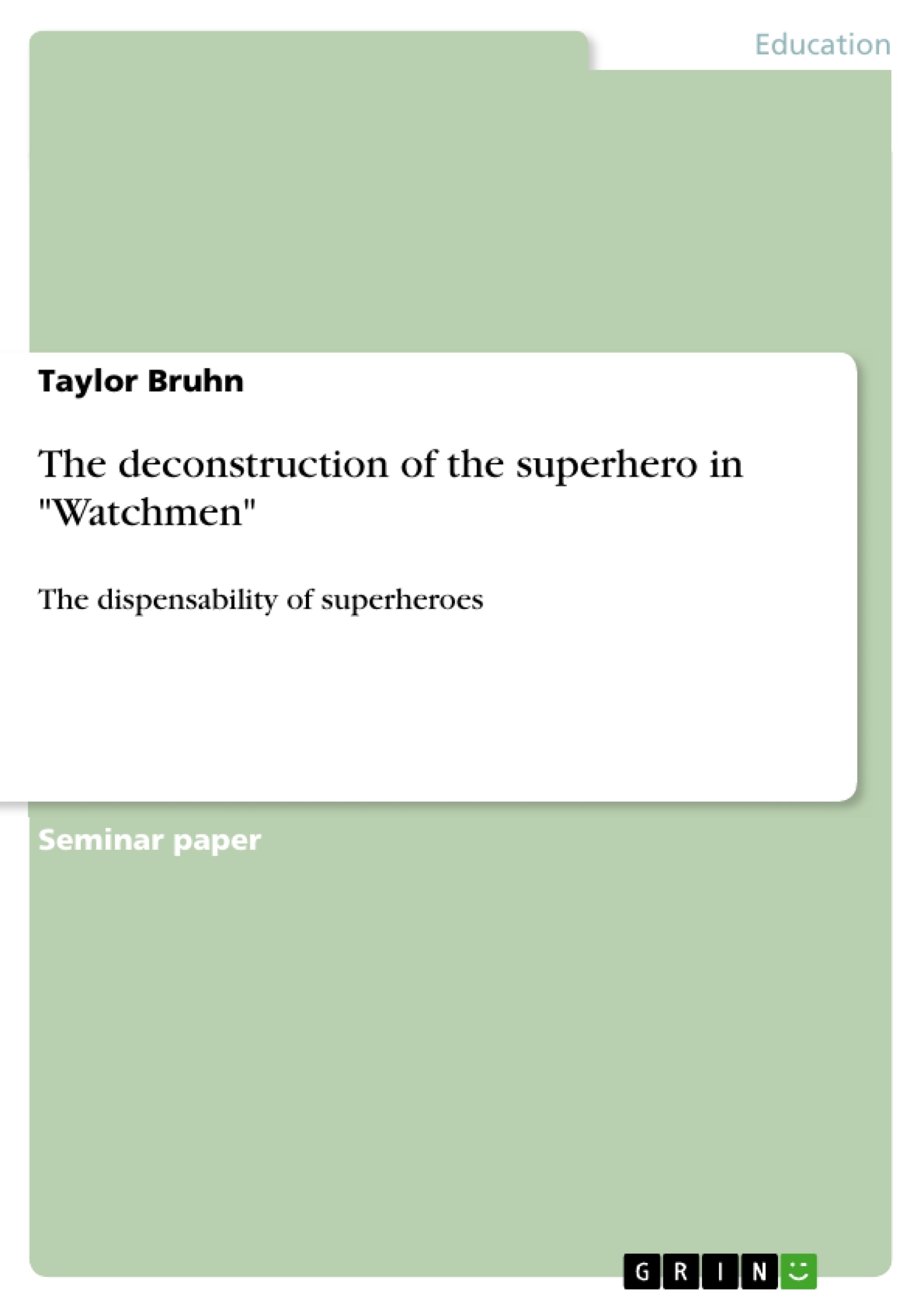This paper analyses the deconstruction of the superhero and its stereotypical features in "Watchmen". The paper assumes that the deconstruction serves as a way to show the dispensability of superheroes. The papers' thesis is therefore that the superheroes in "Watchmen" and their stereotypical features are dispensable and that a life without them is definitely possible and even desirable.
In order to prove this thesis, the paper first presents a definition for stereotypical superheroes. Then, with the help of the definition, it analyses a few of the protagonists of "Watchmen" and their features with respect to their differences to other superheroes and their dispensability. In the conclusion, the results of the analysis will be summarized and a final statement about the dispensability of the superheroes and their superhero features is given.
Inhaltsverzeichnis (Table of Contents)
- 1. Introduction
- 2. Defining the Superhero
- 3. The Deconstruction of the Superheroes and Their Dispensability
- 3.1 Rorschach
- 3.2 Dr. Manhattan
- 3.3 Nite Owl
- 3.4 Ozymandias
Zielsetzung und Themenschwerpunkte (Objectives and Key Themes)
The objective of this paper is to analyze the deconstruction of stereotypical superhero features in Alan Moore and Dave Gibbons' Watchmen and argue for the dispensability of these features, and perhaps even the superheroes themselves. The paper hypothesizes that a life without superheroes, as portrayed in Watchmen, is not only possible but also potentially desirable.
- Deconstruction of Superhero Archetypes
- Dispensability of Superheroes
- Critique of Traditional Superhero Narratives
- Exploration of Morality and Justice
- Analysis of Individual Characters within the Watchmen Universe
Zusammenfassung der Kapitel (Chapter Summaries)
1. Introduction: This introductory chapter establishes the paper's central argument: that Watchmen deconstructs the superhero archetype, demonstrating their dispensability. It highlights the work's divergence from traditional superhero narratives and introduces the thesis that a world without superheroes is not only possible but potentially preferable. The chapter outlines the methodology, which involves defining stereotypical superhero features and then analyzing the Watchmen characters to demonstrate how they deviate from and ultimately defy these established traits.
2. Defining the Superhero: This chapter provides a framework for analyzing the Watchmen characters by defining the conventional characteristics of superheroes. Drawing upon existing scholarship, it identifies three key features: identity (codename and costume reflecting inner character), power (superhuman abilities or exceptional skills), and mission (a prosocial and selfless commitment to fighting evil and injustice). This definition serves as a benchmark against which the Watchmen characters will be measured.
3. The Deconstruction of the Superheroes and Their Dispensability: This chapter, and its subchapters, delve into the analysis of specific Watchmen characters, comparing them to the established definition of a superhero. It examines how each character's traits deviate from the traditional archetype, and how those deviations support the paper's central argument regarding the dispensability of both the characters and the stereotypical features themselves. This analysis is crucial for building the argument toward the overall conclusion (not included in this preview).
Frequently Asked Questions: Watchmen Deconstruction Analysis
What is the main objective of this academic paper?
The paper analyzes how Alan Moore and Dave Gibbons' Watchmen deconstructs stereotypical superhero features. It argues that these features, and perhaps superheroes themselves, are dispensable. The central hypothesis is that a life without superheroes, as depicted in Watchmen, is not only feasible but potentially preferable.
What are the key themes explored in the paper?
The paper explores several key themes, including the deconstruction of superhero archetypes, the dispensability of superheroes, a critique of traditional superhero narratives, the examination of morality and justice, and an in-depth analysis of individual characters within the Watchmen universe.
What is the structure of the paper?
The paper is structured into three main chapters: An introduction establishing the central argument and methodology; a chapter defining the conventional characteristics of superheroes to serve as a benchmark for comparison; and a final chapter analyzing specific Watchmen characters (Rorschach, Dr. Manhattan, Nite Owl, and Ozymandias) to demonstrate how they deviate from and ultimately defy traditional superhero traits, supporting the argument for their dispensability.
How does the paper define a "superhero"?
The paper defines a conventional superhero based on three key features: a distinct identity (codename and costume reflecting inner character), superhuman abilities or exceptional skills (power), and a prosocial and selfless mission to fight evil and injustice.
Which Watchmen characters are analyzed in detail?
The paper focuses on a detailed analysis of four key Watchmen characters: Rorschach, Dr. Manhattan, Nite Owl, and Ozymandias. The analysis compares their characteristics to the established definition of a superhero, highlighting the deviations that support the paper's central argument.
What is the overall conclusion of the paper (as previewed)?
While the full conclusion is not included in this preview, the paper builds its argument towards demonstrating that the deconstruction of superhero archetypes in Watchmen reveals their dispensability. It suggests that a world without superheroes, as presented in the graphic novel, is a possibility and potentially a desirable one.
What is the methodology used in this analysis?
The paper uses a comparative methodology. It first defines the stereotypical characteristics of superheroes, then analyzes the Watchmen characters to illustrate how they diverge from these established traits. This comparison forms the basis for arguing the dispensability of both the characters and their stereotypical features.
- Quote paper
- Taylor Bruhn (Author), 2016, The deconstruction of the superhero in "Watchmen", Munich, GRIN Verlag, https://www.grin.com/document/359041



